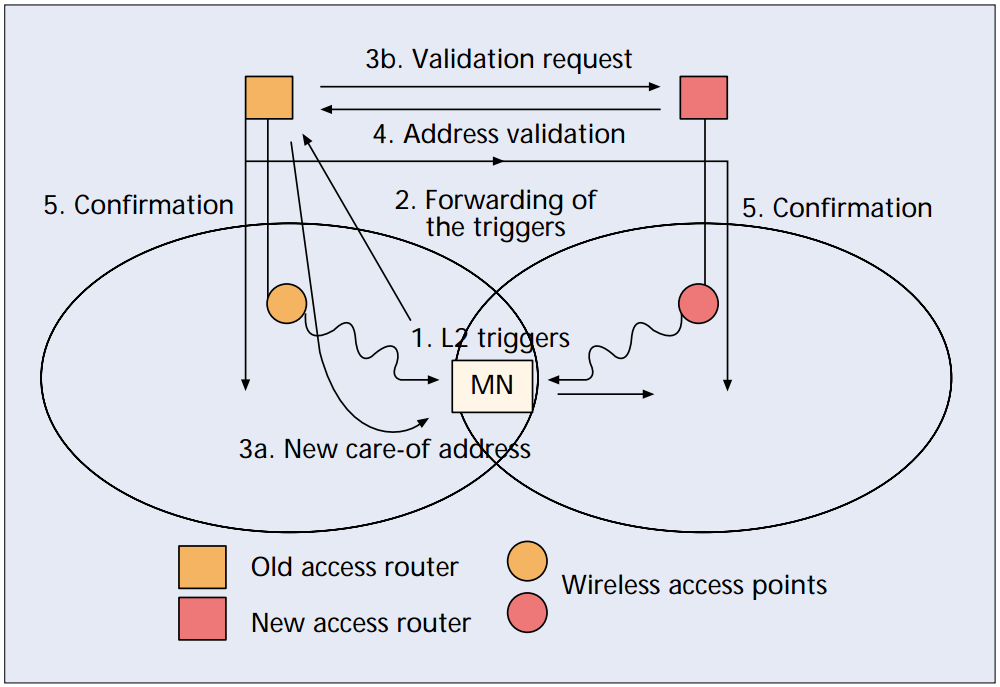Ipv6
- Introduction of IPv6 (IPv4 vs. IPv4) [1]
- Handover management
for mobile nodes in IPv6 networks [2][3]

motivation
- addresses
- Asian countries, especially China, Japan and South Korea
- uniquely address every molecule in the solar system
- world’s population is growing
- IoT


IPV4 vs. IPV6
- Addresses:
- IPv4 - 32 bit (4 bytes) addressing and allows 4,294,967,296 unique addresses
-
IPv6 -
128-bit (16 bytes)
addressing and
allows 340 undecillion
unique addresses.
(340,282,366,920,938,463,463,374,607,431,768,211,456 ) VS. (4,294,967,296)
- Checksum:
- IPv4 - header includes checksum
- IPv6 - header doesn’t contains checksum
- Fragmentation
- IPv4 - Both routers and senders fragment the data
- IPv6 - only Senders can fragment data packets.
IPv4 - 
IPv6 - 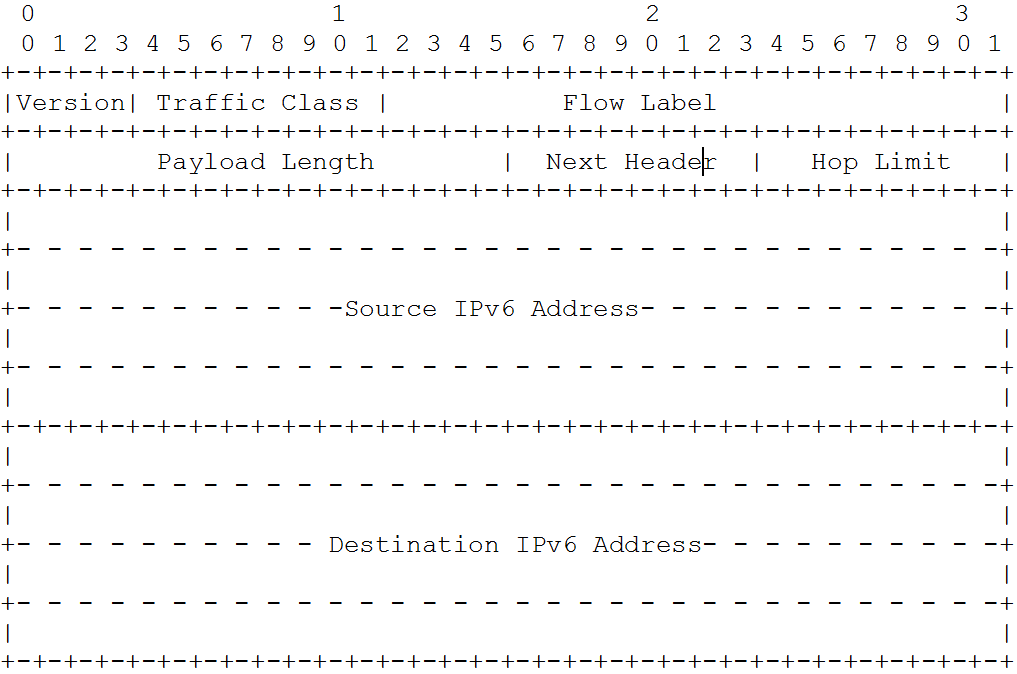

-
Version - 4 -bit Internet Protocol version number = 6
- Traffic Class - 8 -bit traffic class field - QoS?
- Flow Label - 20-bit flow label - May be used for special handling
- Payload Length - 16-bit unsigned integer
- Next Header - 8 -bit selector
- Hop Limit - 8 -bit unsigned integer (TTL)
IPv6 Addresses Format [5]
- IPv6 defines three types of addresses.
- Unicast address specifies a single host ( 1 to 1).
- Multicast is like a broadcast that can cross subnets, Nodes have to subscribe to a multicast group to receive information (One/Many to Many).
- Anycast address is one that is assigned to more than a single interface (Many to Few).
-
There is no broadcast address in IPv6
- IPv6 addresses example:
- FF04:19:5:ABD4:187:2C:754:2B1
- FF01:0:0:0:0:0:0:5A == FF01::5A
- Hybrid - 0:0:0:0:0:0:199.182.20.17 == ::199.182.20.17
ICMPv6 - Internet Control Message Protocol [6][8]
-
ICMPv6 error messages are:
- Destination Unreachable: packet cannot be delivered for reasons other than congestion.
- Packet Too Big: Sent by a router when it has a packet that it cannot forward because the packet is larger than the MTU of the outgoing link.
- Time Exceeded:
- Sent by a router that when the packet's Hop Limit reaches zero.
- if all fragments of a datagram are not received within the fragment reassembly time.
- Parameter Problem: inability to process the header.
IPv6 Extension Headers
- What are Extension Headers?
- How are they identified in the IPv6 Header?
- Extension Header Order
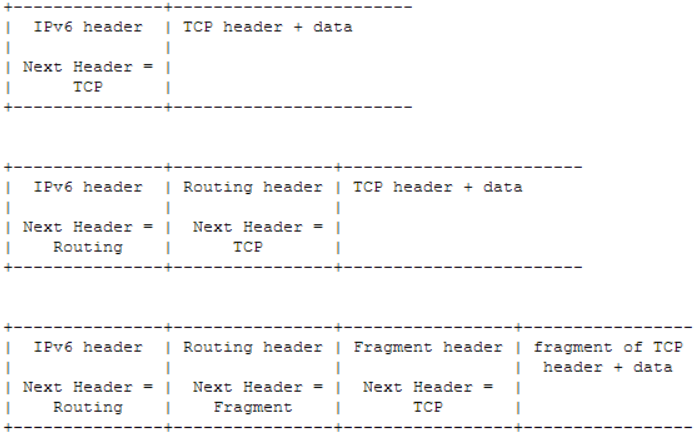
IPv6 Extension Headers [4]
-
0 - Hop-by-Hop Options header
- must be examined by every node along the path.
- Jumbo Payload option "jumbograms" less the 4GB [9]
- 60 - Destination Options header (note 1)
-
43 - Routing header
-
list one or more intermediate nodes to be "visited" on the way to a packet's destination.
-
44 - Fragment header
-
51 - Authentication header (note 2) [10]
-
50 - Encapsulating Security Payload header (note 2) [11]
-
60 - Destination Options header (note 3)
- 59 - Upper-layer header - (e.g., 6 for TCP, or 17 for UDP)
?

Mobile IPv6 Terms
- mobile node ( MN ) : A node that can change its point of attachment from one link to another.
- correspondent node: A peer node with which a mobile node is communicating.
-
home address: A unicast address assigned to a mobile node.
-
home subnet prefix: The IP subnet prefix corresponding to a mobile node's home address.
- home link: The link on which a mobile node's home subnet prefix is defined.
- home agent: A router on a mobile node's home link with which the mobile node has registered its current care-of address
more TERMS
-
Foreign subnet prefix: Any IP subnet prefix other than the mobile node's home subnet prefix.
- Foreign link: Any link other than the mobile node's home link.
- Handover: A process by which the mobile node changes from one link-layer connection to another L2 + L3.
- Care-Of Address: A unicast routable address associated with a mobile node while visiting a foreign network.
-
binding: The association of the home address with a care-of address (lifetime)
-
Binding Update: A Binding Update is used by a mobile node to notify the correspondent node or the home agent of its current binding.
mobile IPv6 - MIPv6
PROBLEM?
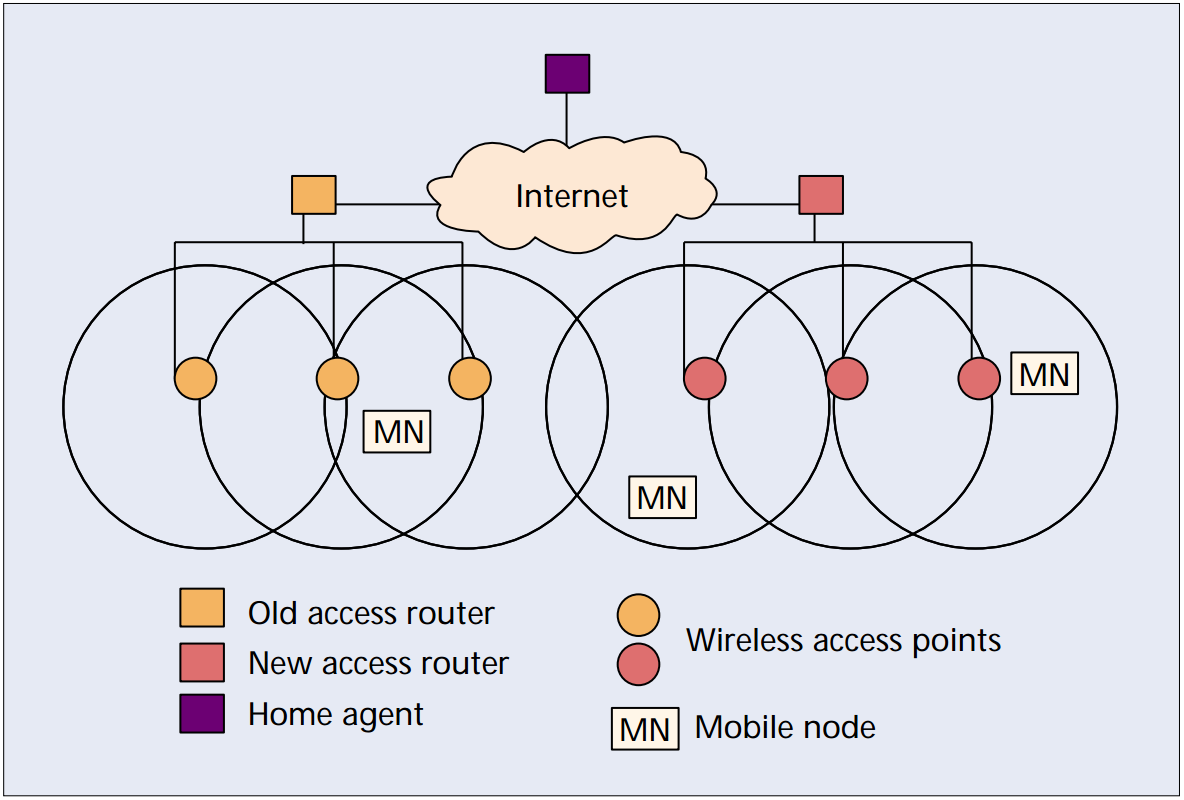
The Handover Procedure
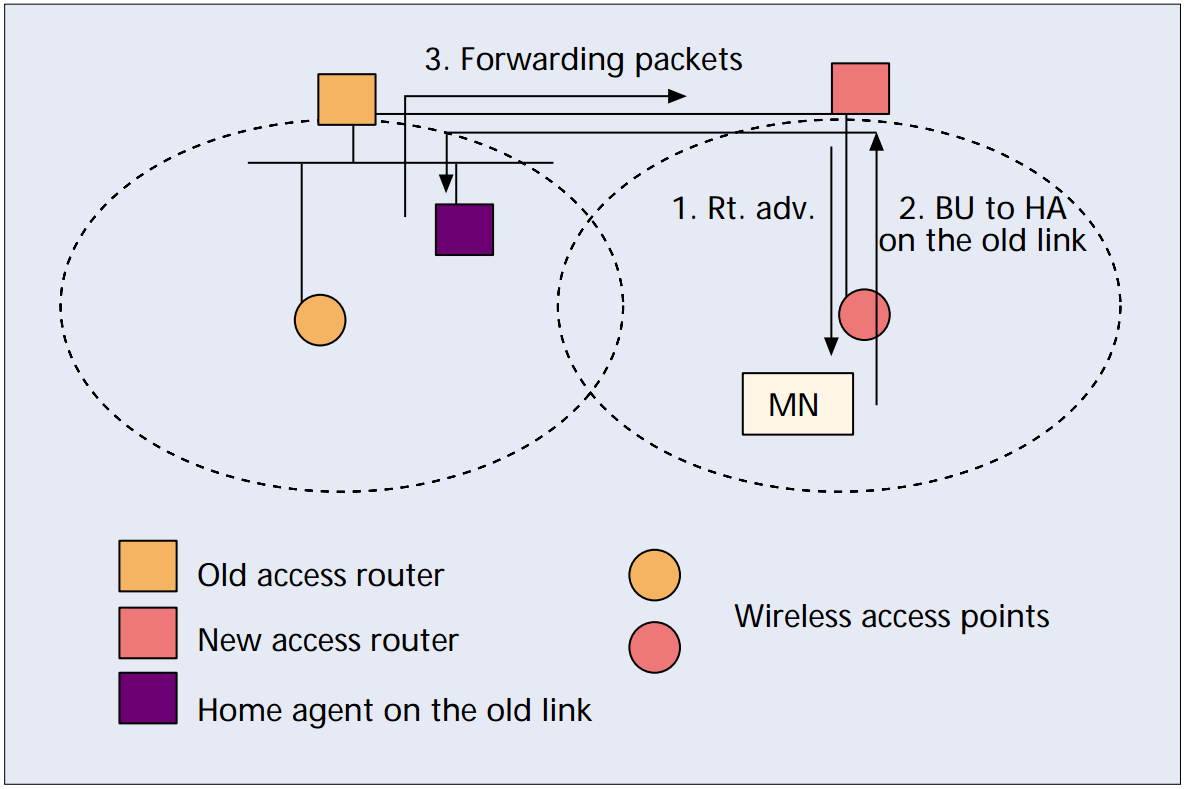
-
MN detects
that it has moved to a new subnet.
-
router advertisement
- router solicitation
- router advertisement allows to create a new care-of address
- stateless
- stateful address autoconfiguration.
THE HANDOVER PROCEDURE

- The MN performs duplication address detection (DAD)
- the MN has to send one or several neighbor solicitation(s) to its new address and wait for a response for at least 1 s.
- the MN must update the binding cache in its home agent and correspondent(s) by sending a binding update.
Suggestions for Enhancement?
-
The MN should perform DAD in parallel.
- Choose not to perform it.
Handover Enhancement
- MN can be reachable through multiple wireless links from physically neighboring APs.
- If these APs are on different subnets
-
One of them must be a primary for a default AR.
- If the default AR becomes unreachable
- the MN can use a new default AR for which it already has a care-of address In addition.
- the packets sent by the correspondent nodes are lost until they receive the binding update.
- MN can switch between two ARs several times (ping-ponging).
HANDOVER ENHANCEMENT
-
Mobile IPv6 requires that the MN to create and register a new care-of address after each movement.
- Bicasting allows the MN to simultaneously register with several ARs.
- All the packets intended for the MN are then duplicated in several potential localizations.
- bicasting performed by the home agent
-
generates lots of traffic on both the wired and wireless links.
HIERARCHICAL MOBILE IPV6 - HMipv6[12]
- Designed to minimize signaling to correspondent(s) and to the home agent.
- The global Internet is divided in regions defining local area mobility. [13]
- mobility anchor point: is an AR with a publicly routable IP address at the top of several ARs.
-
Regional Care-of Address (RCoA):
RCoA is an address allocated by the MAP to the mobile node.
-
On-Link Care-of Address ( LCoA ) :
LCoA is configured on a mobile node’s
interface, based on the prefix advertised by its default router.
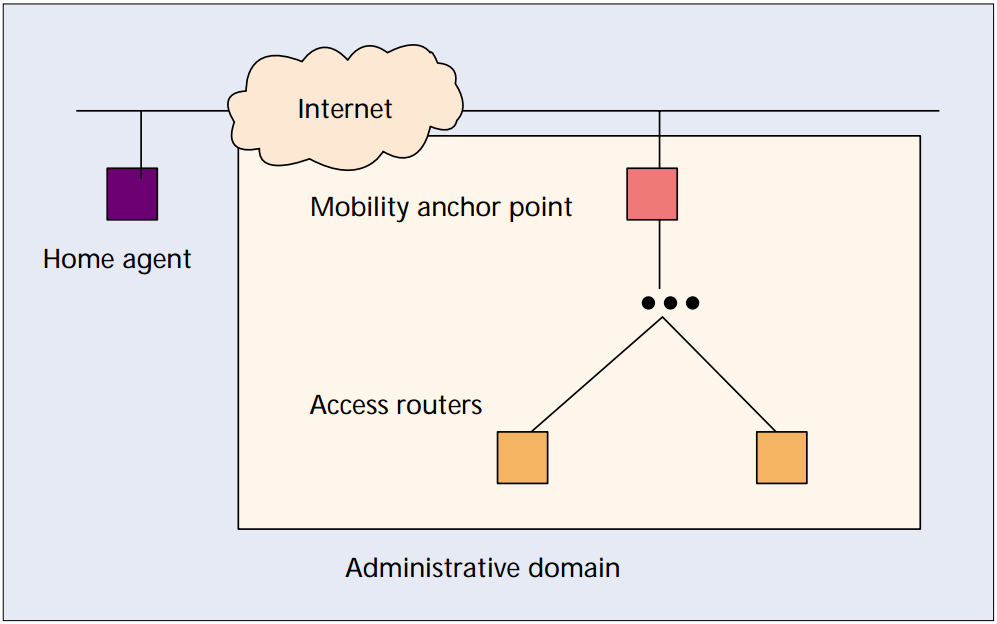
When the Mobile node first enters a domain
-
Make a regional registration to advertise to its home agent and correspondent(s).
- After each movement between ARs in the same domain, the mobile node needs to send a local registration to the mobility anchor point to update its on-link care-of address.
- All mobile node movements within the domain are hidden from the home agent and correspondent(s).
Two Modes of Hierarchical MIPv6
-
Basic mode:
- MN has two addresses:
-
Regional care-of address based on the mobility anchor point prefix.
-
On-link care-of address based on the current AR prefix.
- In this scheme, the mobility anchor point acts as a home agent.
Two Modes of Hierarchical MIPv6
-
Extended mode:
- MN one address:
- Regional care-of address is (one of) the mobility anchor point unique address(es).
-
The mobility anchor point keeps a binding table with the current on-link care-of address of an MN matched with the MN home address == on-link care-of address.
- When it receives packets destined to an MN, it detunnels and retunnels them to the on-link care-of address.
-
This implies that each packet must contain the MN home address.
fmipv6 - fast handover Protocol [14]
- Allows an AR to offer services to an MN in order to anticipate the L3 handover.
-
The movement anticipation is based on the L2 triggers.
- The main L2 triggers used are the following:
- Link Up - MN has established a connection with an AP.
- Link Down - MN has lost a connection with an AP.
- L2 Handover Start - MN starts an L2 handover to attach to a new AP.
- Fast Handover uses these L2 triggers to optimize the MN movements in two methods:
- Anticipated handover
- Tunnel-based handover
Fast Handover – Tunnel-Based Handover
-
It only performs an L2 handover and continues to use its old care-of address in the new subnet.
- The MN does not need to exchange any packets: the two ARs set up a bidirectional tunnel from the L2 triggers without interacting with the MN.
?
referances
- [1] Gupta, Meenakshi. "IPV4 vs. IPV6."
- [2] Johnson, David, Charles Perkins, and Jari Arkko. "Mobility support in IPv6." (2004): 2004
- [3] Montavont, Nicolas, and Thomas Noel. "Handover management for mobile nodes in IPv6 networks." Communications Magazine, IEEE 40.8 (2002): 38-43.
- [4] Deering, Stephen E. "Internet protocol, version 6 (IPv6) specification." (1998).
- [5] Hinden, Robert M., and Stephen E. Deering. "Internet protocol version 6 (IPv6) addressing architecture." (2003).
-
[6] Conta, Alex, and Mukesh Gupta. "Internet control message protocol (icmpv6) for the internet protocol version 6 (ipv6) specification." (2006).
- [7] Postel, Jon. "RFC 791: Internet protocol." (1981).
- [8] Deering, S., and R. Hinden. "RFC 2460: Internet Protocol, Version 6 (IPv6) Specification (1998).
- [9] Borman, David A., Stephen E. Deering, and Robert M. Hinden. "IPv6 Jumbograms." (1999).
- [10] Kent, Stephen, and Randall Atkinson. "RFC 2402: IP authentication header." (1998).
- [11] RFC2406, E. S. P. "IP Encapsulating Security Payload (ESP)." S. Kent, R. Atkinson (1998).
- [12] Soliman, Hesham, et al. "Hierarchical mobile IPv6 (HMIPv6) mobility management." (2008).
notes
- 1: For options to be processed by the first destination that appears in the IPv6 Destination Address field plus subsequent destinations listed in the Routing header.
- 2: Additional recommendations regarding the relative order of the Authentication and Encapsulating Security Payload headers are given in [RFC-2406].
- 3: For options to be processed only by the final destination of the packet.
Bicasting in Hierarchical Architecture
- bicasting performed by the mobility anchor point.
-
can generate too much delay in packet delivery.
-
Packets are only duplicated within
the domain.
- Subjects that are still under discussion since it causes problems:
- Discovery of the other mobility anchor point(s).
- Selection of one mobility anchor point by the MN.
- Load balancing among multiple mobility anchor points.
Copy of IPv6
By Asaf
Copy of IPv6
seminar
- 588
